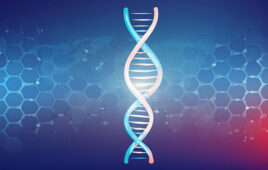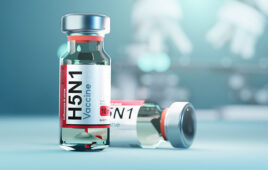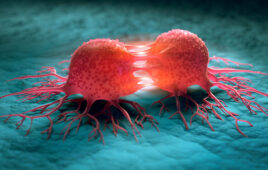Long a mainstay of the industry, natural products fell out of favor in the 1980s and 1990s, but there are signs of renewed interest.
Patrick McGee, Senior Editor
The history of natural products is a long one, ranging from the possible use of medicinal herbs by Neanderthals through ancient civilizations such as Mesopotamia, Egypt, Greece, and Rome. They continued
 |
to play a major role throughout the 20th century, and today, more than half the drugs on the market are natural products or derived from natural products. But despite that record of success, working with natural products has historically been a slow, inefficient process, and traditional natural product extract libraries were not compatible with high-throughput screening
In the mid-1980s pharmaceutical companies began to look for more scalable approaches to drug discovery using technologies like synthetic chemistry libraries, combinatorial libraries, and high-throughput and ultra-high-throughput screening, a trend that continued throughout the 1990s. In addition, pharma’s reduced interest in drugs for infectious diseases, the vast majority of which are derived from nature, further eroded the status of natural products.
But the pressure the pharmaceutical industry is under today due to shrinking product pipelines has many companies reconsidering their move away from natural products and taking a second look at compounds derived from traditional sources like plants and soil, and less traditional sources such as marine organisms. “The driving force of that interest is that companies are looking for ways to improve their discovery organizations and improve their productivity,” says Frank Koehn, PhD, director of natural products and discovery analytical chemistry at Wyeth Research, Pearl River, N.Y. “The other driving force is now that combinatorial chemistry and high-throughput screening of combi libraries have reached a place where they’re certainly more mature than they were 20 years ago, their pros and cons have been more accurately realized. There are some serious shortcomings to high-throughput screening of synthetic compound libraries.”
One is the difficulty of synthesizing libraries of compounds that have a great deal of chemical diversity. The early libraries, while very large in numbers of compounds, were very narrow in chemical diversity. The reason for this is that your library contains what you’re able to make, so methodologies for synthesizing libraries of compounds in the early days were not very good relative to what was needed to attain a high degree of chemical diversity. David Newman, DPhil, acting chief of the natural products branch at the National Cancer Institute, is even more blunt: “The original combinatorial libraries, I will go on record as saying, were effectively worthless, mainly because—and this sounds odd—they were not natural product-like enough.”
Newman says much has changed over the last several years. Companies have learned from their mistakes and are now producing better combinatorial chemistry libraries by focusing on what he calls the “chemical DNA,” the intellectual thought process behind devising a structure that becomes a drug. “It’s Mother Nature’s intellectual input, so to speak,” Newman says. “What has happened now is, instead of making a million or two million compounds, people are now making very focused libraries. What they are doing is taking a skeleton that either is natural or close to natural and then proceeding to modify it.”
Mixing and matching
Newman cites the work of Herbert Waldmann, PhD, as a prime example of this approach. Waldmann, a professor of chemical biology at the Max Planck Institute for
Molecular Physiology in Dortmund, Germany, took a protein inhibitor based on a natural product and found that modifying it slightly allowed it to inhibit other proteins. “Nobody in their right mind would ever have thought this was the case,” Newman says. “He’s used the natural product and then done combinatorial chemistry around it. He’s mixing and matching. This is where I see the beauty of a natural product, in that it’s been primed to do something.”
The work of Waldmann and others underscores another attractive feature of natural products, something known as privileged structure, a term coined in the 1980s to describe chemical structures with innate characteristics that make them bioactive. An example of research with privileged structures can be seen in the work of K.C. Nicolau, PhD, a chemist at The Scripps Research Institute in La Jolla, Calif. Several years ago, after surveying the literature, he determined that there was a basic two-ring structure that was found in over 11,000 natural products, mainly derived from plants. He developed a combinatorial method of making the structure, and then began experimenting with it by making focused libraries.
“He didn’t make a million of them; he made 1,000 of this shape and 1,500 of that and 2,000 of something else,” Newman says. “He then assayed them in high-throughput screens and, to date, has published five or six papers showing simple structures based on this that have activities that nobody would even dream about. He’s even found antibiotic activity against vancomycin partially-resistant enterococci from a structure that nobody would ever have considered to have antibiotic activity.”
In addition to the elucidation of privileged structure, things are also being helped along by an increased understanding over the last few years of the concept of chemical diversity, Koehn says. While researchers thought they were creating diverse libraries in the 1980s and early 1990s, they now realize that wasn’t so. “One of the reasons that natural products is becoming more of an interest again is the fact that there is no doubt that natural products libraries contain a very high degree of chemical diversity that would be very difficult to achieve synthetically,” Koehn says. “If you take a library of extracts from a wide variety of microorganisms or plants, you will find the chemical diversity to be far greater than an equivalent number of compounds in a synthetic library. This is now very attractive because we realize that to be successful in finding new drug scaffolds that are really innovative and will have activity against a wide variety of targets, it’s important to have as much chemical diversity in your library as possible if you’re going to do high-throughput screening.”
Scary molecules?
But despite those advances and the promise they offer, many are still leery of working with natural molecules due to their complexity, says Bruce Sargent, PhD, vice
 |
president of discovery research and development at Albany Molecular Research Inc. (AMRI), Albany, N.Y. “We see this when we talk with potential clients about screening natural products,” Sargent says. “When they find natural product hits, people are actually frightened by them. They think they look like scary molecules.” That’s likely because they are often fairly complex molecules that do not fit the rules for a drug-like compound.
But history has shown that many complex products that break those rules can actually be very good drugs. “In some way natural products seem to be charmed in their ability to get to the body and do certain things, even though they have functional groups that would be unattractive in conventional molecules or characteristics that would suggest that they would not make good drugs. It takes a certain mindset to get past that and recognize the potential value in natural products that has been washed out of people’s thinking,” Sargent says.
The natural products program at AMRI got a boost three years ago when the company inked a deal that resulted in Eli Lilly and Company transferring its extensive natural products collection, advanced technology natural product library, and related databases over to AMRI. The collection includes microorganisms, plant samples, and marine invertebrates, and a library of more than 100,000 samples. Under the deal, AMRI screens samples from Lilly’s collection, as well as those from its own natural product libraries, for activity against disease targets identified and provided by Lilly.
Their experience has taught them a few methods for getting around industry chemists’ fear of natural product molecules, Sargent says. “One of the approaches we have taken is to develop biological technologies, or what we call biocatalytic technologies, that allow us to use biological systems to make modifications to the natural products. That allows regular chemistry on it, so that kind of gets you away from the complex looking molecule that frightens the chemists a bit.”
While chemists and the industry in general seem to be very leery of natural products, Thomas Henkel, PhD, believes the positives far outweigh the negatives. Henkel is the CEO of InterMed Discovery GmbH in Dortmund, Germany, a company formed in April when Bayer HealthCare AG spun out its natural substance research unit as part of a restructuring. “Natural products have all of a sudden attracted a lot of interest because, if you know how to do it right, you can immediately define unique selling points, you can immediately define new chemistry, and you can immediately distinguish your chemistry from the well-known chemistry that others are doing with very high amounts of investment,” Henkel says.
From the land…
Perhaps one of the most well-known natural products on the market is Taxol (paclitaxel), which became a blockbuster drug when it came on the market in 1993 for the treatment of ovarian cancer. Today, Taxol’s maker, Bristol-Myers Squibb (BMS), New Brunswick, N.J., takes in an estimated $1.6 billion a year from Taxol, which is derived from a substance extracted from the bark of the Pacific yew tree. A number of other cancer drugs have been derived from natural sources, including a newer class of drugs, the dolastatins, says Sargent. Isolated from the Indian Ocean sea hare Dollabella auricularia, these linear peptide molecules are promising anti-cancer drugs that have demonstrated potency against breast and liver cancers, solid tumors, and some leukemias. They are now in clinical trials.
For the past several years, Samuel Danishefsky, PhD, a chemist at Memorial Sloan-Kettering Cancer Center in New York, has focused on the synthesis of a class of drugs called the epothilones. Danishefsky was the first to synthesize the key epothilones and has since created more than 100 analogs. The epothilones come from the bacterium Sorangium cellulosum, originally isolated from soil found on some African riverbanks. The epothilones use the same mechanism that Taxol does to block an essential part of cell division. But the epothilones appear to be less toxic to healthy cells than some other drugs and are effective against tumors resistant to Taxol and other drugs. One epothilone analog in the preclinical stage that appears particularly promising is Fludelone, which has been studied for its effectiveness in killing cancer cells.
Kosan Biosciences Inc., Hayward, Calif., has cloned the epothilone gene cluster, expressed it in two different organisms, and demonstrated production of all important forms of epothilone. The company’s lead epothilone, KOS-862 (Epothilone D), is being evaluated in three phase II studies as a treatment for breast cancer, non-small cell lung cancer, and prostate cancer. Other companies with epothilone drugs in their pipelines are BMS and Novartis Oncology.
Another key area historically for natural products has been antibiotics, and this has not changed. Last June, Wyeth launched Tygacil (tigecycline IV), which Koehn says is a fifth or sixth generation tetracycline. “While this is a synthetic modification of an existing type of natural product, tetracycline, which has been around since the 1940s, it’s a good illustration of the fact that oftentimes natural products, their mechanism of action due to their chemical diversity, is such that you can continue to leverage that mechanism. You will find that there are oftentimes multiple generations of natural products that are drugs.” Another of Wyeth’s natural products now in the clinic is CCI-779, a rapamycin ester that Koehn says leverages a unique biological mechanism of rapamycin in a new way to treat cancer.
At AMRI the natural products approach focuses on tried and true sources such as microbes and fungi as opposed to newer sources such as marine organisms, says Joanne Johnson, PhD, of the company’s business development group. “Our aim is to try to find technologies and libraries that would allow us to actually take something to the point where it could be commercial. We’re relying on fermentation as a way of developing new compounds and have actually been able to make things at a scalable cost.” Johnson believes that while plant and marine life are great sources for natural products, they are challenging because finding enough material to scale up to commercial production can be difficult. She adds that a major source for their natural products collection will be actinomycin in fungi.
To the sea…
While many are sticking with more traditional terrestrial sources for natural products, others, like William Fenical, PhD, are looking to the sea. Fenical, director of the
 |
Center for Marine Biotechnology and Biomedicine at the Scripps Institution of Oceanography at the University of California, San Diego, believes this makes perfect sense as oceans are what characterize Earth. He says the biodiversity of the oceans is underscored by fact that 34 of the 37 phyla of life occur in the ocean, as opposed to only 17 of 37 on land. “Why be discouraged about natural products when the greatest resource of biological and genetic diversity resides in the oceans?” he asks. “But the fact is that the pharmaceutical industry cannot investigate the ocean because they have never invested in the scientific concepts of the ocean, so they don’t know how to do it.”
NCI’s Newman believes marine organisms are the greatest potential source for new natural products because they provide a vast number of unique compounds. For example, Newman says, NCI has collected large numbers of plants from around the world that yield compounds that kill cells. But when the chemical structure of these compounds is determined, it is found that they are known chemistry. “There are a few exceptions, but that’s a general rule,” he says. “In the case of the marine environment, when we find an active compound, we are finding compounds we’ve not seen before, chemistry we’ve not seen before.” Many marine-based compounds are already in the pipeline. For example, there are eight molecules that work in a manner similar to Taxol in various stages that came from a marine microbe or other marine organism.
The work of Fenical and his colleagues is assuring that more of these types of leads will continue to be discovered. They have developed methods and tools to extract marine mud from as deep as 3,000 feet, and they have taken samples from the Atlantic and Pacific Oceans, the Red Sea, and the waters off California. Five years ago, they brought back deep-ocean samples that led to the discovery of 15 new genera of actinomycetes, bacteria that live in marine mud. For the last 50 years, terrestrial actinomycetes have played a huge role in the pharmaceutical industry because of their ability to produce antibiotics such as actinomycin, streptomycin, and vancomycin. Fenical’s group isolated 100 strains of the marine version of this bacteria and found that 80% produced molecules that inhibit cancer cell growth, while about 35% demonstrated the ability to kill pathogenic bacteria and fungi.
They named one of the marine actinomycetes that they discovered Salinosporamide A, which has been shown to be a “very potent” inhibitor of cancers, including human colon carcinoma, non-small cell lung cancer, and breast cancer, Fenical says. The work Fenical’s group does builds on a long history of success. One of their early ones was pseudopterosin, an anti-inflammatory chemical found in the Caribbean sea whip Pseudo-pterogoria elisabethae, a type of coral. Due to its success in alleviating allergic responses on the skin, pseudo-pterosin is used in an over-the-counter skin cream, and it has the potential to be used for psoriasis, sunburn, and arthritis.
Newman says more natural products are likely to continue coming on the market as researchers continue to plumb the depths of the world’s oceans. He estimates that there are 350,000 species of plants worldwide. “You can add at least one zero to that when you talk of species of marine invertebrates, and if you want to talk about species of microbes, you can add an awful lot of zeros, because if you take one milliliter of seawater you have over 100,000 microbes,” Newman says. That’s compared to a gram of terrestrial soil, which can yield about 1,000 different species of microbes.
Something that could play a key role in sifting through all these marine organisms are metagenomics approaches being developed. For example, J. Craig Venter, PhD, president of the Venter Institute, has funded one such project in which a ship gathers 200 liters of seawater every 200 miles. The water is filtered to isolate microbes, then their genomes are taken and shotgun cloned in the same manner used to map the human genome. “They’re finding phenomenal numbers of quite different organisms. So the real diversity is in the microbes,” Newman says.
While the work of Fenical, Newman, Venter, and others underscores the potential of natural products, there are still a number of challenges. One very practical issue is whether there is an adequate supply of the natural product to allow for investigation of the compound and full-scale production for the marketplace if it is approved. In the case of pseudopterosin, Fenical and colleagues were able to develop a method for collecting the coral that allowed it to grow back healthier than it had been before being harvested. However, if the supply is inadequate and the compound is not amenable to synthesis, that will mean the termination of the research program.
A second issue is optimization, because very few compounds are of high enough quality to become a drug directly, says InterMed’s Henkel. “Normally when you have a synthetic compound there is a total synthesis already known which is a very basic understanding, so this is not the hurdle for the chemist, but for the natural products they have that hurdle. . . . Since it is very seldom that you have total synthesis available, the hurdle for chemistry to optimize those natural products is high, so that’s also another very practical aspect.” A third difficulty is that natural products require a different work flow due to the optimization assays and other tasks required. “You need to have confidence in being able to control those processes,” Henkel says. “All companies try to simplify their internal processes, and having a second process parallel to the normal process is always something difficult. I think the trend will be for companies to reduce the complexity of this natural product activity.”
Fenical believes the main hurdle is to change the industry’s mindset, especially when it comes to marine natural products. He says that in the late 1980s and into the 1990s, industry was spending $10 billion worldwide to look for terrestrial microbes. “Nobody’s done that with the marine environment at all,” he says, adding that good work can be done for relatively little money. “I spend $1 million a year and I have two drugs in clinical trials. . . . When are people going to use these incredibly new resources and utilize them as they need to be used? I think they are frightened of them.”
Filed Under: Drug Discovery




